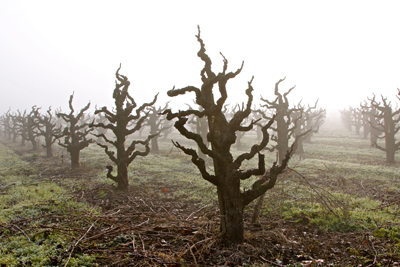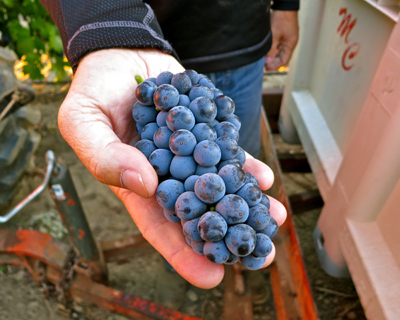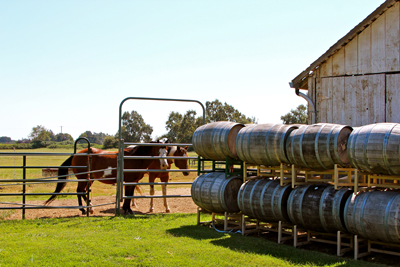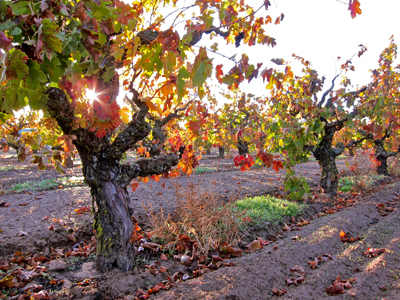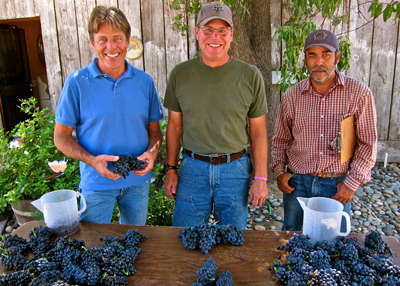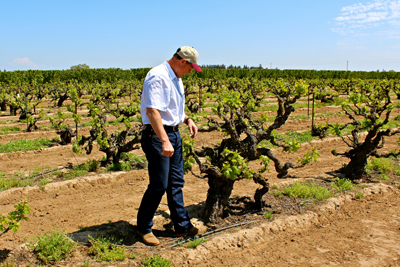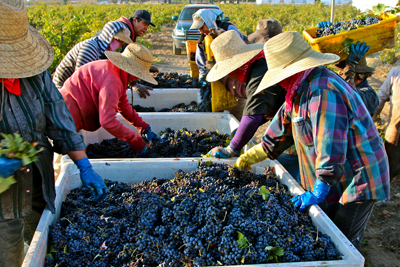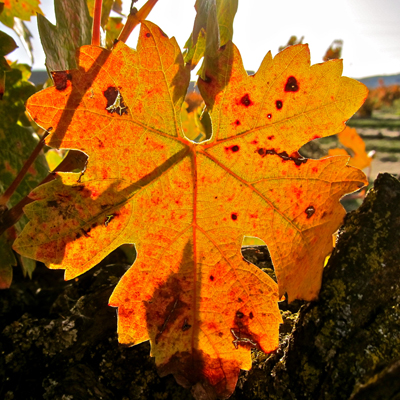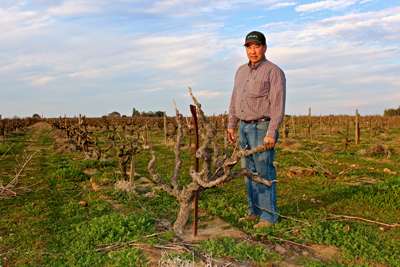Letters from Lodi
An insightful and objective look at viticulture and winemaking from the Lodi
Appellation and the growers and vintners behind these crafts. Told from the
perspective of multi-award winning wine journalist, Randy Caparoso.
The mystery of Zinfandel, part 2 – the long strange trip from… somewhere
Maley Vineyards Zinfandel (west side of Lodi’s Mokelumne River AVA) with telltale corkscrew-twisting spurs typical of vines grafted to St. George rootstocks
Continuation from The Mystery of Zinfandel, part 1 - a plot as thick as the wine
Did you know that the first winery to produce a rosé, or pink colored “White Zinfandel,” from the black skinned Zinfandel grape was Lodi's El Pinal Winery – way back in 1869? El Pinal did not survive Prohibition, and it would not be until the late '60s/early ’70s that wineries like David Bruce, Ridge, Monteviña and, of course, Sutter Home would revive the idea of turning Zinfandel into something other than a red table wine.
According to Charles Lewis Sullivan in his book, Zinfandel: A History of a Grape and Its Wines, El Pinal's technique of turning free-run Zinfandel juice into a pinkish wine was so highly thought of that California viticultural commissioner Charles Wetmore – a pioneer of California white wines, and also the founder of Livermore Valley's Cresta Blanca Winery (in 1882) – openly advocated the use of Zinfandel to produce a "white" wine.
Lodi has long since become associated with Zinfandel because it crushes over 40% of the California crop each year. Many of the region's currently existing vineyards are very old – first planted as far back as the late 1880s to early 1900s. But where does Lodi stand in respect to the entire history of Zinfandel in this state?
Zinfandel from 80-year old Mokelumne River AVA planting
First, lest you think otherwise, the oldest continuously farmed vineyards in California today are not planted to Zinfandel; but rather to the Mission grape (a.k.a. Criolla) in Amador County – Mother Lode country. There, the Deaver family cultivates Mission originally planted as far back as 1853 (over 160 years ago!).
These plants are not just museum pieces: Deaver's Mission grapes are used primarily to produce a sweet, fortified style of dessert wine called Angelica – most of this, by an extraordinary winemaker named Marco Cappelli, who crafts these wines for a number of wineries – in a style that dates back to the 1700s, when the Spanish order of Franciscans first began to establish their outposts along El Camino Real from Mexico to the San Francisco Bay, planting Mission grapes nearly everywhere along the way.
Soon after the 1850s, however, Zinfandel supplanted Mission as California's most widely planted grape because early vintners quickly recognized the fact that it made dry table red wines superior to Mission in every way. Since many of the pioneers of European descent first came to California in search of gold in the Sierra Foothills, it is no surprise that the oldest existing Zinfandel planting today is also located in Amador County's Shenandoah Valley: the Original Grandpère Vineyard, planted in 1869 (grapes going to a handful of exceptional producers, such as Scott Harvey and Lodi's Macchia Wines).
Historic Jessie’s Grove Winery estate
Not everyone struck gold in the Foothills, of course, and so when settlers poured down into San Joaquin Valley they found thousands of acres of rich farmland, begging to be ranched or planted with wheat, fruit and nut trees, row crops, and of course, grape vines. Captain Charles M. Weber acquired 49,000 acres of land through a Spanish land grant, and in the 1850s he founded a community that would become the City of Stockton. In 1852, a friend of Weber's named George West paid a visit, and a plan for going full-time into the grape growing business was launched.
In 1853 George West and his brother William established their first vineyard at the north end of Stockton, close to the Calaveras River where it intersects with the present-day Lodi AVA (the Sorelle Winery estate now sits on a small piece of what was once part of the West property). Five years later the Wests founded El Pinal Winery, which immediately became profitable.
The Wests planted grapes from cuttings furnished by Captain Weber, as well as a collection of 40 cultivars sourced from a nursery in Boston. We do not have a list of those grapes originally planted by El Pinal in the 1850s. But in his book, Sullivan writes that the Wests were cultivating Zinfandel at least by the 1860s; and that in 1883 a Lodi grown El Pinal Zinfandel was also submitted to a viticultural convention in San Francisco.
Ancient Bechthold Vineyard Cinsaut, planted 1886
We do have documents listing grapes in the El Pinal nursery that was preserved by the family of Joseph Spenker, who purchased cuttings in 1885 to plant on his 1,000-acre property just west of Lodi – a small town originally settled in the 1850s, and incorporated as a city in 1906. Jessie's Grove Winery now dominates most of Spenker's original square-mile property. In 1886 Spenker planted 25 acres of a “Black Malvoisier” (later identified as Cinsaut), which is still cultivated by Spenker's heirs – a block now known as Bechthold Vineyard. At the same time Spenker planted grapes that were listed as Madeline, Black Hamburg, Sweetwater, Black Ferra, and Emperor.
In 1889, Spenker planted a second vineyard consisting primarily of Zinfandel, mixed in with Carignan, Mission, Tokay, and Black Prince (the latter, later identified by the California Department of Agriculture as Rose of Peru). This block – today called Royal Tee Vineyard – is Lodi's oldest continuously farmed Zinfandel planting, and is owned by Jessie's Grove Winery. It is thought that that the first "Flame Tokay" – a brilliantly pink, plump variety of Vitis vinifera grown primarily as a table grape – was planted in Lodi as early as 1857; and that by the 1890s the two most widely planted grapes in Lodi were Tokay and Zinfandel.
Both Lodi and Amador County played crucial roles in the ongoing proliferation of Zinfandel in 1880s and 1890s, when the root louse known as phylloxera devastated vineyards throughout California – temporarily maiming the wine industry in Napa Valley, Sonoma County, and Livermore Valley. Plantings like the Original Grandpère Vineyard survived phylloxera because of its remote location in the Sierra Foothills. Lodi's Zinfandel plantings proved resistant because of the extremely deep, sandy soil that dominates the region along the winding Mokelumne River: phylloxera can survive in sandy soils, but not in sufficient enough populations to cause harm to Vitis vinifera roots grown in that medium.
Jessie’s Grove’s Greg Burns (left), showing off mix of grapes (Zinfandel, Carignan and Black Prince) from Royal Tee Vineyard (planted 1888)
If you know your wine history, you will recall that phylloxera first hit Europe during the 1850s via American plants collected by avid botanists in Victorian England. Because native, wild American grape vines have always been pretty much immune to these sap sucking insects, it became apparent that the only feasible solution to the destruction of vineyards in Europe as well as in the U.S. was to graft native European vines onto stumps of phylloxera resistant American vines.
Because it was never completely necessary to replant with grafted vines in Lodi, this is why there are thousands of acres of ungrafted, or "own-rooted," Zinfandel in Lodi today – among the largest commercial plantings of Vitis vinifera in the world still growing on their own natural roots. There are also significant plantings of ungrafted Vitis vinifera in Chile and South Australia. Closer to home in Contra Costa County (where the soil is even sandier than in the Mokelumne River AVA), there are numerous small, productive stands of ungrafted Zinfandel, as well as Carignan and Mission, dating back to the late 1800s.
The use of the roots of one particular American plant, called Vitis rupestris, became very popular in the area around the Southern French town of Saint-Georges'd’Orques, and so in the 1890s rupestris – renamed St. George – was introduced to Californians. St. George quickly became popular among Zinfandel growers because it provided the exceptionally deep rooting system, especially in poor soils and areas prone to droughts, upon which Zinfandel seemed to thrive. Interestingly, Vitis rupestris is not actually a grape vine, it is a grape bush that once grew wild on prairies, and in gravelly creeks and sand bars, all over central U.S. (from Texas to West Virginia), and is now listed among endangered plant species.
Craig Rous in his Rous Vineyard (planted in 1909 on St. George rootstock)
To this day, many viticulturists and winemakers still believe that St. George is the best possible rootstock for Zinfandel. Virtually all the existing old vine Zinfandel planted between the 1890s and 1960 in Sonoma County and Napa Valley are on St. George rootstocks. Although most of the Zinfandel vines planted in Lodi prior to 1960 are own-rooted, a handful of the region's most highly regarded vineyards – such as Rous Vineyard (planted in 1909), and the Maley family's Wegat Vineyard (1958) – are planted on St. George.
Otherwise, the exact route Zinfandel might have taken to get from its original home in Croatia to California earlier in the nineteenth century is somewhat circuitous — the evidence, circumstantial. Hints and innuendos. For starters, we know that George Gibbs, a horticulturist on Long Island, received shipments of wine grapes from Schönbrunn in Vienna, Austria between 1820 and 1829. In his definitive book on the grape, Charles L. Sullivan suggests that the “Black Zinfardel of Hungary” mentioned by William Robert Prince in A Treatise on the Vine (1830) may be referring to one of Gibbs’ 1829 acquisitions. Gibbs visited Boston in 1830, and a Boston nurseryman named Samuel Perkins began selling a “Zenfendal” soon afterwards – which may, or may not, be another early documented listing of Zinfandel in the U.S.
Another possible thread: in the 1830s Gibbs also listed a grape called “Black St. Peter's” – a moniker found in nurseries in England, where many vines had “St. Peter's” in their names. Not much is known of this Black St. Peter's grape. What is known is that there was a grape called Black St. Peter's planted extensively in California, starting in the 1850s; which eventually proved very popular – especially in Sonoma County – and by the 1870s became better known as a variant of Zinfandel.
Zinfandel harvest; Lodi’s Noma Ranch (own-rooted 100-year old vines)
Then there is the San Jose grape grower named Antoine Delmas, who made documented claims that he imported a grape called Black St. Peter's directly from France in 1852, and was making prize winning wines from it by 1858 (re David Darlington, Zin: The History and Mystery of Zinfandel). Was this, too, Zinfandel? The evidence, alas, is not conclusive.
After 1835 still another Boston nursery owner named Charles M. Hovey began recommending a “Zinfindal” as a table grape. There was also a reference to “Zinfindal” in Practical Treatise in the Culture and Treatment of the Grape Vine (first published in 1847) by John Fisk Allen of Salem, MA. Were these, too, early references to the Zinfandel we know today?
Sullivan also cites a Captain F.W. Macondray, a member of the Massachusetts Horticultural Society, who saw a specimen of the "Zinfindal" mentioned by J. Fisk Allen in a Society exhibition. Macondray later relocated to San Francisco; presumably with cuttings of said "Zinfindal," which soon passed on to Joseph W. Osborne in Napa Valley, and from there fell into the hands of Vallejo winemaker Dr. Faure. It is Osborne, speculates Sullivan, who may have made the first wine purely from Zinfandel in the late 1850s, from his vineyard located in the vicinity of Oak Knoll in Napa Valley.
Zinfandel leaf in autumn (Noma Ranch)
In the same era, the flamboyant Count Agoston Haraszthy – often called the "Father of California Viticulture" – founded Buena Vista Winery in Sonoma Valley in 1857. Soon after, Haraszthy went to Europe, traveled through five countries, and brought back some 100,000 cuttings of over 350 different grape varieties. Was one of those grapes Zinfandel? The Count's son, Arpad Haraszthy, was very vocal in his belief that Count Haraszthy was the first to import and plant Zinfandel in California, as early as in the 1850s – a claim that Mr. Sullivan has suggested as possibly delusional.
Whatever his source might have been, we do know that Arpad Haraszthy was making good use of Zinfandel in Sonoma Valley by the 1860s; utilizing the grape to produce both red wines and sparkling wines for his Buena Vista Vinicultural Society label (incorporated from the original Buena Vista property in 1863).
Further examples that there were more 1850s sightings of Zinfandel in California than Elvis are several sources making note of the fact that A.P. Smith, who founded his Pomological Gardens in 1848, was exhibting a "Zeinfindall" grape among over 1,000 other varieties of fruit trees and vines in his Sacramento nursery. In Inventing the Dream: California Through the Progressive Era, Kevin Starr suggests that this was a Zinfandel "progenitor."
Since Smith also founded a satellite nursery in Placerville, it has been speculated that this was the likely source of Zinfandel plantings throughout Amador County. Or was it? In the late 1850s another Placer County grape pioneer named James Nickerson was reportedly cultivating a "Back Finfindal" among some 50 other varieties, primarily sourced from a Sacramento agriculturist named Wilson G. Flint. In the late 1850s there was also a Dr. Samuel Page who established a vineyard and winery south of Jackson in Amador County; including a "Black St. Peters" which may or may not have been a Zinfandel cultivar.
Despite its murky history and notwithstanding the slight blip known as Prohibition (1920-1933), Zinfandel (along with Carignan) remained the most widely planted wine grape in California during much of the twentieth century. The usage of Zinfandel has evolved in sync with the tastes of the American wine consumer: for most of the past century Zinfandel was used primarily to produce generic "jug" wines; then mostly for White Zinfandel during the 1980s; and by the end of the 1990s, mostly to produce varietal red wines. Premium and ultra-premium brands of varietal Zinfandel are now everywhere.
Today California's top grapes are Chardonnay (closing in on 100,000 planted acres) and Cabernet Sauvignon (over 76,000 acres and climbing). Zinfandel is now #3 (still nearly 47,000 acres), with Merlot (hanging in at about 45,000 acres) right behind it. Great news for Zinfandel lovers who can never get enough of it… and especially for Lodi, which has always banked on this grape's enduring popularity!
Leland Noma in one of his own-rooted Zinfandel vineyards in east side of Lodi’s Mokelumne River
